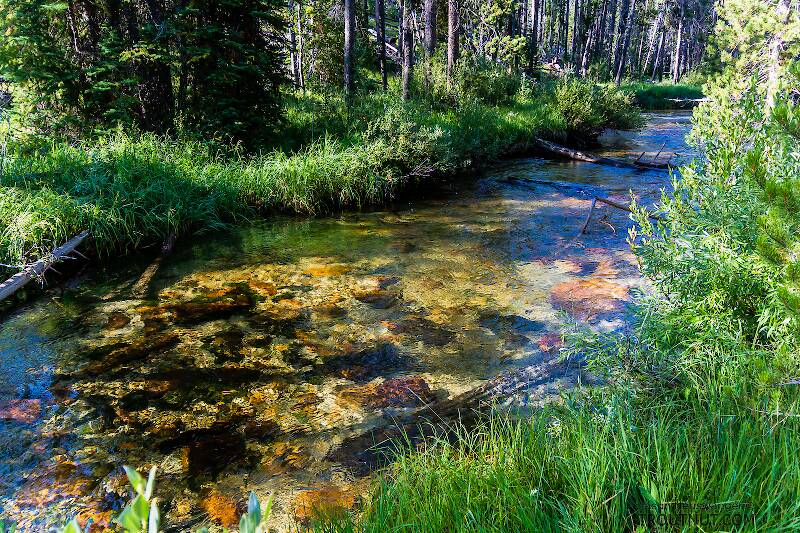
Salmonflies
Pteronarcys californica
The giant Salmonflies of the Western mountains are legendary for their proclivity to elicit consistent dry-fly action and ferocious strikes.


Stonefly Species Diura bicaudata (Lapland Springflies)
Species Range
Physical description
Most physical descriptions on Troutnut are direct or slightly edited quotes from the original scientific sources describing or updating the species, although there may be errors in copying them to this website. Such descriptions aren't always definitive, because species often turn out to be more variable than the original describers observed. In some cases, only a single specimen was described! However, they are useful starting points.
Description from GBIFthe Global Biodiversity Information Facility
Source: Diura Washingtoniana (Hanson) Resurrected From Synonymy With Diura Nanseni (Kempny) (Plecoptera: Perlodidae), Supplemented With A Description Of The Larva And Egg And Comparison To Other Congeners
Adult habitus. General color in alcohol similar to that of Diura washingtoniana. Markings on head, pronotum, and mesoeusterna and metaeusterna (Figs. 46, 47, 55) similar to Diura washingtoniana. However, Brinck (1949) reports that head coloration is variable. A well-developed sternacostal suture (Fig. 47 ss), as observed in Diura washingtoniana (Fig. 3) and Diura nanseni (Fig. 32), is present in Diura bicaudata.
Male. Body length (Lillehammer 1974, Stewart and Oswood 2006) similar to that of Diura washingtoniana. Typically micropterous (Lillehammer 1974) but Brinck (1949) concluded that several populations with macropterous males are actually this species. In this study Mongolian populations with micropterous males exhibiting wings terminating prior to the 2 nd abdominal segment or reaching the mid-section of the abdomen as well as populations with macropterous males exhibiting wings reaching the abdominal apex or beyond are considered to be this species as well. Tergum 8 (Fig. 48) bearing a narrow, longitudinal, lightly sclerotized median strip; setose but lacking short, stout sensilla basiconica. Tergum 9 similar to that of Diura nanseni in that the hind margin (Fig. 48) exhibits a broad, lightly sclerotized, median U-shaped area separated by a short distance from a more anteriorly located narrow, longitudinal, lightly sclerotized median band; presence of mesal patches of short, stout sensilla basiconica similar to Diura washingtoniana. Tergum 10 with median, pale, longitudinal lightly sclerotized strip interrupted mesally by darkly sclerotized band connecting the adjacent tergal halves (Fig. 48); distribution of setae and sensilla basiconica similar to that of Diura washingtoniana and Diura nanseni. Epiproct also absent. Paraproct caudal projections in dorsal and ventral view (Figs. 48, 50, 51, 56) with outer surfaces somewhat flattened, not robustly convex as are those in Diura washingtoniana and Diura nanseni, setal lengths variable but generally shorter than those of preceding species; in lateral view (Figs. 49, 50, 57, 59, 60) subtriangular, tapering to narrowly rounded apical margins.
Female. Body length (Lillehammer 1974) similar to Diura washingtoniana. Macropterous, forewing length (Lillehammer 1974) similar to Diura washingtoniana. Sternum 9 bearing two oblique brown bands (Figs. 52). Subgenital plate shape variable (Figs. 53, 58) (Brinck 1949, Lillehammer 1974); plate width overlaps that of Diura nanseni but can be wider, ca 2.3 – 6.5 X wider than long. Vagina and spermatheca membranous; spermatheca (Fig. 54 s) ovoid or egg-shaped, nearly as long as wide (1.3 x longer than wide); spermathecal duct (sd) 0.5 x length of vagina; spermatheca and duct bearing accessory glands (ag).
Larva. Originally described by Hynes (1941), other information provided by Brinck (1949, 1952), Illies (1955), Hynes (1958) and Lillehammer (1988). Closely similar to Diura washingtoniana, except that the lateral pronotal margins are lined with a row of short spinulae and a few longer hairs at the posterolateral corners (Fig. 77).
Egg. First illustrated by Lillehammer (1988) and nearly identical to Diura washingtoniana and Diura nanseni (Fig. 78).
Source: Diura Washingtoniana (Hanson) Resurrected From Synonymy With Diura Nanseni (Kempny) (Plecoptera: Perlodidae), Supplemented With A Description Of The Larva And Egg And Comparison To Other Congeners
Lapland Springfly http: // lsid. speciesfile. org / urn: lsid: Plecoptera. speciesfile. org: TaxonName: 934 Figs. 46 - 60, 76 - 77
Start a Discussion of Diura bicaudata
References
- Merritt R.W., Cummins, K.W., and Berg, M.B. 2019. An Introduction to the Aquatic Insects of North America (Fifth Edition). Kendall/Hunt Publishing Company.
Stonefly Species Diura bicaudata (Lapland Springflies)
Species Range
Common Name
Resources
- NatureServe
- Integrated Taxonomic Information System
- Global Biodiversity Information Facility
- Described by Linnaeus, C. (1758) Systema naturæ per regna tria naturæ, secundum classes, ordines, genera, species, cum characteribus, differentiis, synonymis, locis. Tomus I. Editio decima, reformata. Holmiae :Impensis Direct. Laurentii Salvii. Available from: http://www.biodiversitylibrary.org/item/10277 1-824

